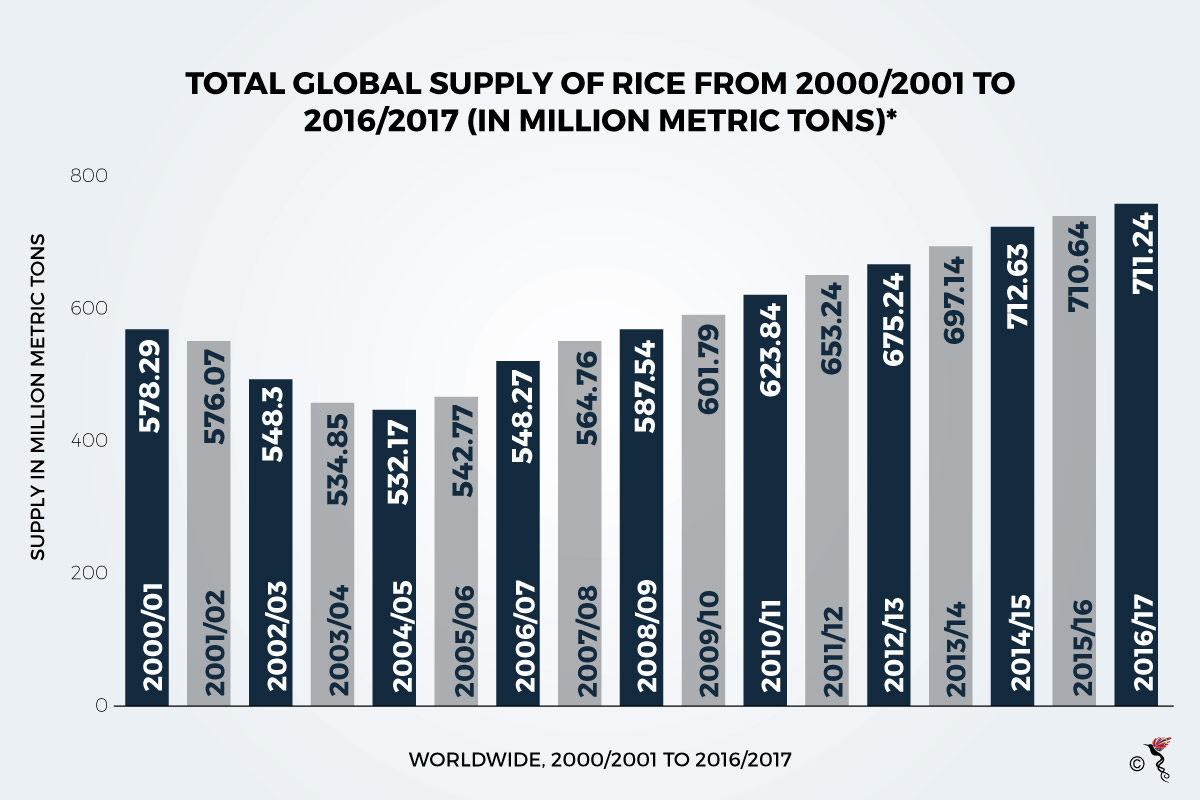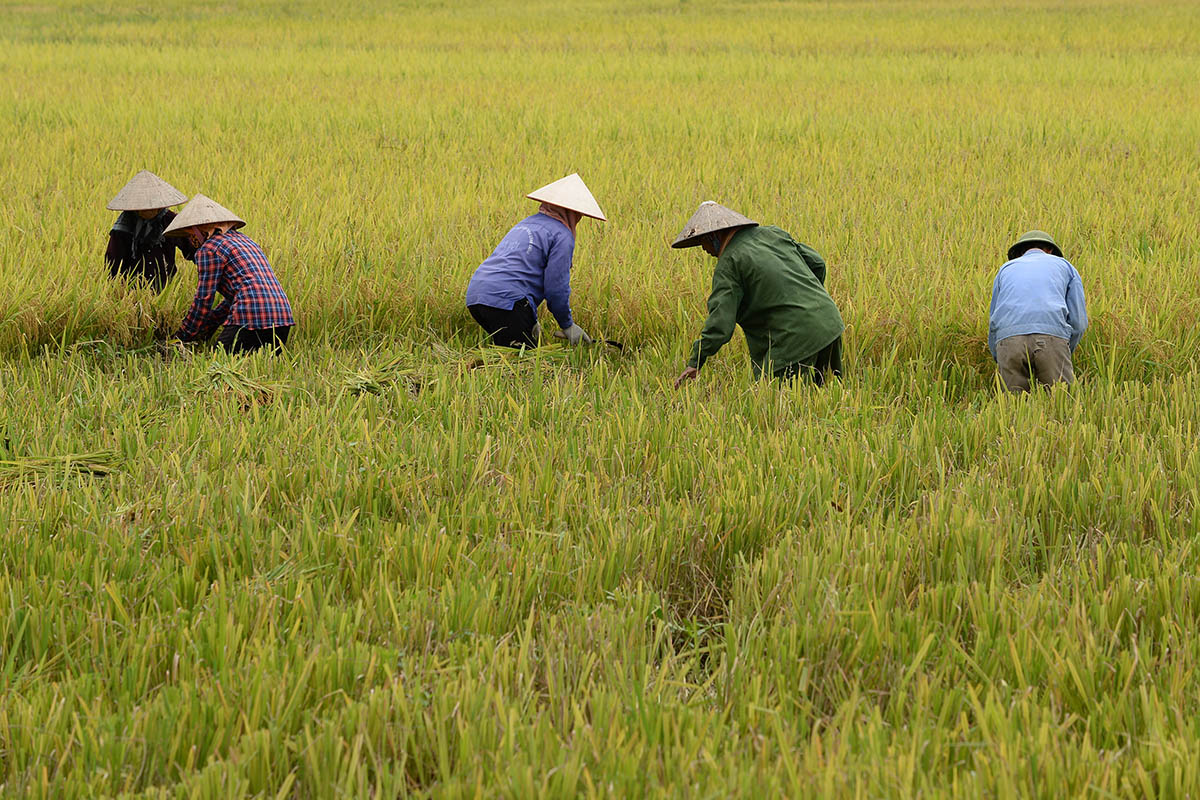Southeast Asia produces 90% of the world's rice supply, which means global rice supply is significantly affected whenever extreme weather conditions disrupt production cycles. Extreme weather conditions, however, are increasingly common as the result of global climate change.
Prolonged droughts in Thailand, for instance, during the mid-2016 period resulted in a 16% drop in rice production due to the lack of water supply delaying harvests.
Diseases brought on by pests, higher global temperatures and increasing soil salinity have also been identified as threats toward rice crops.
On a global level, it has been estimated by the International Food Policy Research Institute that rice yields could drop as much as 10-15% by 2025, resulting in a 30-37% rise in rice prices globally by 2025.
Rice accounts for 20% of global calorie intake, with 475,635 metric tons of rice consumed worldwide in 2017 alone.

Source: Statista
Use of nuclear technology
One of the strategies that has been developed to sustain steady rice supplies is the use of gamma rays to develop greater crop resilience against climate change. Isotope techniques, on the other hand, help to improve water management and fertiliser effectiveness in the planting of rice crops.
In Vietnam, nuclear technology has been used to develop seven mutant varieties of rice thus far, which has benefited 300,000 rice farmers since 2012, according to Director of the Field Corps Research Institute, Nguyen Trong.
Modified species of rice plants are developed using the irradiation process whereupon gamma rays are used to induce seed mutation, mimicking the natural mutation process to produce random genetic variations. These are then tested for various characteristics, such as tolerance to floods, droughts and high salinity.
The results of gamma ray irradiation on the mutation process differs according to exposure time, irradiation dose given and amount of substance exposed to irradiation. Successful traits can be used to reproduce further seeds, which can then be distributed amongst farmers.
Isotopic techniques on the other hand can be used to study the rate of fertilizer absorption in rice plants. This was applied in the Philippines, which implemented a system whereby it split fertilizer application into four different time periods. This resulted in 50% higher yields and cost savings of almost US$4 million per season.
In the Philippines, such isotopic techniques have also been used to reformulate water use, resulting in 35% of water savings for irrigation purposes there, according to the Philippine Nuclear Research Institute.
Taking examples from other parts of Asia, it is also apparent how the potential of nuclear technology could extend further in this region, with some varieties produced in Bangladesh capable of being harvested one month earlier with similar high yields and quality of grain.
All these efforts are needed to sustain the livelihoods of Southeast Asia’s 140 million rice-farming households, as well as expand national incomes through increased rice exports.
Global food demand is expected to grow by 60% by 2050, against a projected global population size of 9.8 billion by 2050, from the current 7.3 billion.
Indonesia, for one, needs to increase its rice production to help meet the needs of its 20-million strong population size in a self-sustaining manner. Despite being the third largest rice producer in the world after China and India, its rice consumption is also higher than neighbouring Malaysia and Thailand. Indonesia has been importing rice from Thailand and Vietnam, with rice imports totalling three million tons annually, but it still aims to become a rice exporter in the near future.
Facilitating the future of rice
Despite current levels of success surrounding the implementation of nuclear technology in rice fields, more facilities, funding and research are likely to be needed to meet Southeast Asia’s rice needs over the long term.
The International Atomic Energy Agency (IAEA) has been responsible for most of the research and its implementation through the provision of workshop training and facilitating of fellowships between countries. It is currently partnering the Food & Agriculture Organisation of the United Nations (FAO) to conduct research in its laboratories based in Austria to support researchers across 70 countries worldwide.
Most recently, IAEA successfully signed a deal with OPEC’s Fund for International Development for funding food security across several areas, including a US$400,000 allocation focused on improving the sustainability of rice production in Cambodia, Laos, Bangladesh and Nepal.
More facilities would also be needed. For example, Vietnam is working with Russia to establish a Nuclear Science & Technology Centre in Hanoi for research and development into the uses of nuclear technology across industries, including agriculture.
Nuclear technology has proven to be quite effective in improving the sustainability of rice harvests. This technology, however, is not a catch-all and must still be used in conjunction with other methodologies to create better growth conditions overall. This must come with a clear strategy on the part of rice-producing ASEAN.
Recommended stories:
China's growth data to set tone for emerging markets this week
Foreign investors key to Vietnam’s retail growth, but can it last?
